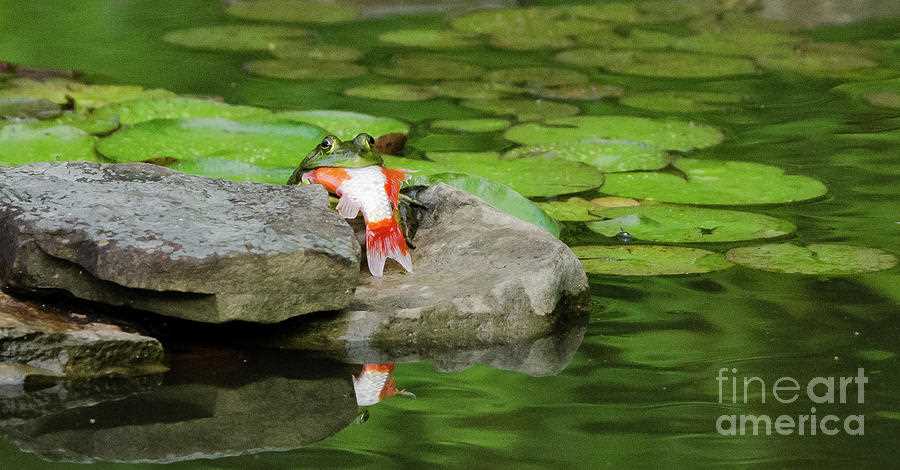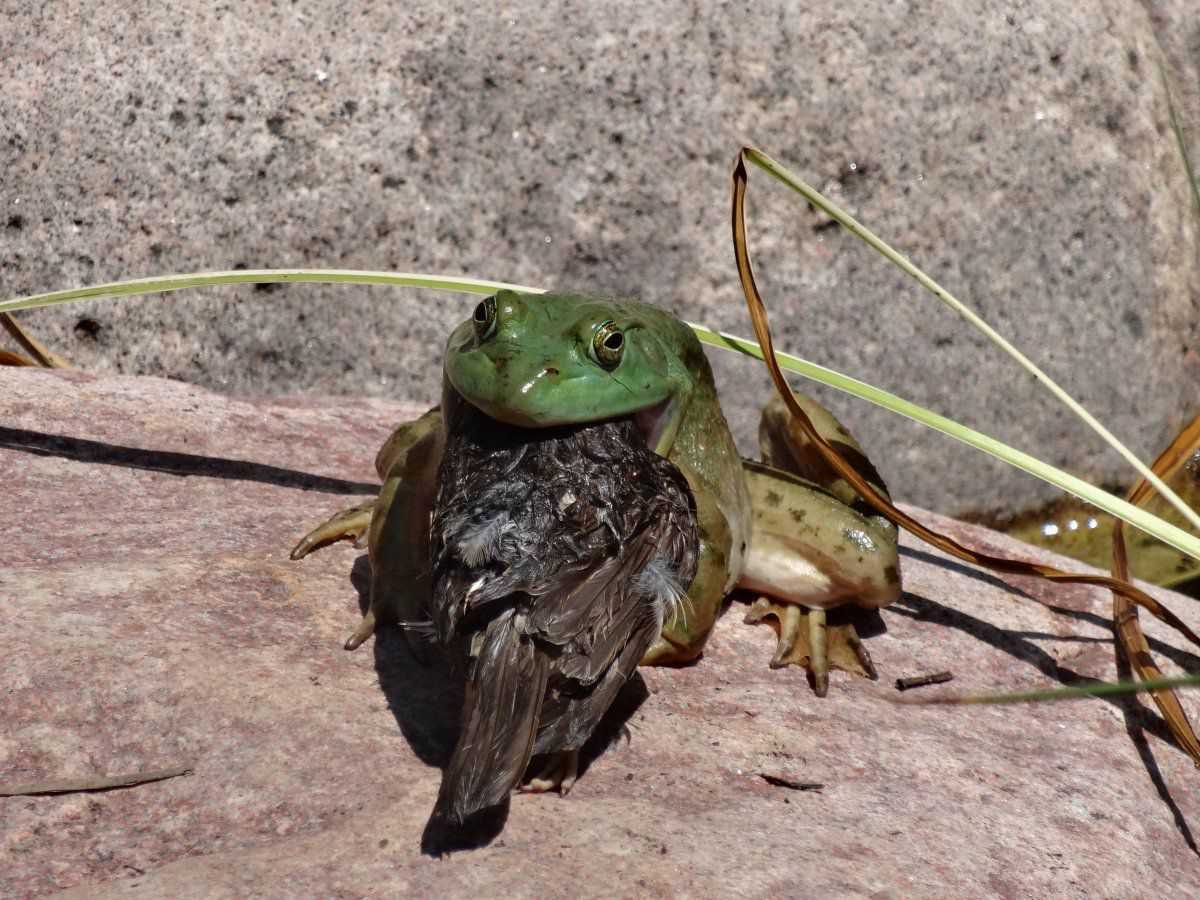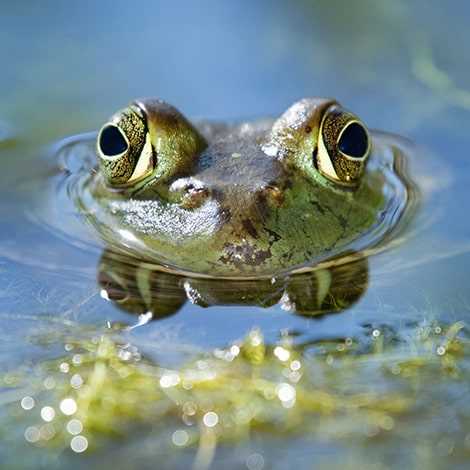Frogs are fascinating creatures with diverse dietary preferences, but can they eat goldfish? Let’s delve into the intriguing world of these amphibians and explore their feeding habits.
Goldfish are a popular choice for home aquariums due to their vibrant colors and graceful swimming. But can they become a meal for a hungry frog?
Can Frogs Eat Goldfish?

One common question among frog owners is whether frogs can eat goldfish. While it may seem logical for frogs to eat goldfish, the answer is not straightforward.
Frogs are carnivorous animals and have a wide variety of diet options, including insects, small fish, worms, and even small mammals. However, not all frogs have the ability to consume large prey like goldfish.
It is essential to understand the specific species of frog before considering feeding them goldfish. Some frogs have smaller mouths and digestive systems that can only handle smaller food items, while others have a more robust appetite and can consume larger prey.
The Digestive System of Frogs
Frogs have a unique digestive system that allows them to swallow food whole. When a frog catches its prey, it uses its sticky tongue to grab the food and swiftly retract it into its mouth. The prey is then swallowed whole and passes down the esophagus into the stomach.
In the stomach, digestive enzymes break down the prey into smaller pieces. The nutrients are then absorbed into the frog’s bloodstream through the walls of the stomach and intestines. The waste products are eliminated through the cloaca, which is a common opening for excretion and reproduction.
Potential Harmful Effects of Eating Goldfish
If a frog is capable of eating a goldfish, there are potential risks associated with this diet choice. Goldfish are typically larger than the usual prey of frogs, and their hard scales and bones can be difficult for the frog’s digestive system to break down.
Swallowing a large goldfish can lead to bloating, indigestion, and even blockages in the frog’s digestive tract. These blockages can be life-threatening and may require veterinary intervention.
The Impact of Feeding Goldfish to Frogs
Feeding goldfish to frogs can also have ecological consequences. Goldfish are not native to many habitats and can have a negative impact on local ecosystems if released into the wild. Therefore, it is essential to consider the potential ecological effects before using goldfish as a food source for pet frogs.
Alternatives to Feeding Goldfish to Frogs
Instead of feeding goldfish to frogs, there are several alternative food options available. Insects, such as crickets and mealworms, are an excellent source of protein for frogs. Additionally, commercially available frog pellets can provide a balanced diet for pet frogs.
It is crucial to consult with a veterinarian or do thorough research on the specific dietary needs of the frog species in question. This way, you can ensure a balanced and suitable diet for your pet frog.
So what do frogs eat? The diet of frogs largely depends on their size, habitat, and species. Most frogs are carnivorous, meaning they primarily eat meat. Common prey items include insects such as flies, mosquitos, beetles, and ants. Larger frogs are capable of consuming small vertebrates like mice, lizards, and even small birds.
Frogs have a unique feeding mechanism that sets them apart from other animals. Their long, sticky tongue is used to catch and grab prey, which is then quickly retracted into their mouth. This swift and effective method allows frogs to capture their food with precision and accuracy.
Frogs also have a keen sense of sight and rely on their vision to locate and capture prey. They are capable of detecting movement and quickly striking their target. This visual hunting strategy is especially important for frogs that live in aquatic environments, where they often hunt for prey in water.
What Do Frogs Eat in the Wild?
Frogs are carnivorous animals, which means they primarily eat other animals. Their diet consists mainly of insects, such as flies, mosquitoes, and beetles. They also consume spiders and small invertebrates like worms and slugs. Some larger species of frogs may even eat small birds, mice, or other amphibians.
Frog Feeding Habits
Frogs are opportunistic feeders, which means they will eat whatever prey is available to them. They are skilled hunters and use their long, sticky tongues to catch their prey. When hunting, frogs will sit still and wait for their prey to come close. Once within range, the frog will rapidly extend its tongue and capture the prey with adhesive mucus on its tongue’s surface.
Most frogs are nocturnal, meaning they are most active at night. They have excellent vision in low light conditions, allowing them to locate and catch their prey effectively. Some species of frogs are also known to have a keen sense of hearing, which helps them detect the movements of prey.
Feeding on Goldfish: Can Frogs Do It?
It is worth noting that frogs will eat anything they can fit into their mouths, which includes small fish. However, it is unlikely that a frog would be able to catch and eat a goldfish in most cases. Goldfish are generally faster swimmers than frogs, making them difficult prey to catch.
Furthermore, goldfish are typically kept as pets in artificial environments, such as fish tanks or ponds, where they are protected from predators like frogs. If a frog were to be introduced into a goldfish tank, it is possible that it could attempt to eat the goldfish. However, this would not be a natural behavior for the frog.
Conclusion
Examining the Digestive System of Frogs
The Digestive Process
Frogs have a unique digestive system that allows them to consume a wide range of prey. Their digestive process begins in the mouth, where they catch and swallow their food whole. Unlike humans, frogs do not chew their food. Instead, their sticky, muscular tongue helps them capture and retract prey into their mouth.
Once inside the mouth, the food travels through the esophagus and into the stomach. In the stomach, digestive juices and enzymes begin to break down the food, extracting nutrients that the frog needs to survive.
The partially digested food then moves into the small intestine, where further digestion and nutrient absorption take place. Finally, any undigested waste passes through the large intestine and is expelled from the body as feces.
Can Goldfish Be Digested?
While frogs have a versatile digestive system, it turns out that goldfish are not an ideal food source for them. Goldfish are high in fat and protein, which can be difficult for frogs to break down and digest properly. This can result in digestive issues and poor nutrition for the frog.
- Goldfish can be difficult for frogs to digest due to their high fat and protein content.
- Swallowing a goldfish whole may pose a choking hazard or cause digestive blockages.
- Not all frog species can handle goldfish as part of their diet.
- It is advisable to seek professional advice before feeding goldfish to frogs.
Potential Harmful Effects of Eating Goldfish for Frogs
The Digestive System of Frogs
Frogs have a unique digestive system that allows them to consume a wide variety of prey. They are opportunistic eaters and will consume anything they can fit into their mouths. However, not all types of food are beneficial for frogs, and some can even be harmful.
When a frog eats prey, it goes through a process of swallowing the food whole. The prey then travels down the frog’s esophagus and enters the stomach, where it is broken down by powerful enzymes. From there, the partially digested food moves into the small intestine, where further digestion and absorption of nutrients occur. Finally, any waste material is excreted through the frog’s cloaca.
Potential Harmful Effects
While goldfish may seem like a suitable food option for frogs, there are several potential harmful effects that should be considered.
Additionally, goldfish often contain a high amount of thiaminase, an enzyme that can destroy vitamin B1 (thiamine). Thiamine deficiency can have severe consequences for frogs, including neurological disorders and muscle weakness. Feeding goldfish as a staple food source for frogs can lead to a chronic thiamine deficiency, which can be detrimental to their overall health.
Lastly, goldfish that are raised in captivity and used as feeders may be exposed to various toxins, such as pesticides or heavy metals. These toxins can accumulate in the goldfish’s tissues and be passed on to the frog when consumed. Prolonged exposure to these toxins can have negative effects on the frog’s health and well-being.
Considerations for Alternatives
In light of these potential harmful effects, it is recommended to explore alternative food options for feeding frogs. There are several commercially available frog diets, which are specifically formulated to provide a balanced and nutritious diet for frogs. These diets often contain a mix of insects, such as crickets or mealworms, along with vitamins and minerals to ensure the frog’s nutritional needs are met.
Can Frogs Catch and Eat Goldfish?
Frogs are generally opportunistic feeders, meaning that they will eat whatever food source is available to them. In the wild, frogs primarily consume insects, spiders, worms, and other small invertebrates. Their diet can also include small vertebrates such as mice, lizards, and even other frogs.
However, eating goldfish can be harmful to frogs, especially if the goldfish are treated with chemicals such as pesticides or medications commonly found in fish tanks. These chemicals can be toxic to frogs and can lead to serious health issues or even death. It is also important to note that goldfish are not a natural part of a frog’s diet and may not provide the necessary nutrients that frogs need to thrive.
Feeding goldfish to frogs can have a negative impact on their health and well-being. Goldfish are often high in fat and lack important nutrients that are essential for a frog’s growth and development. Additionally, the consumption of goldfish can disrupt the balance of a frog’s digestive system, leading to digestive problems, vitamin deficiencies, or other health issues.
Potential alternatives to feeding goldfish to frogs include providing a varied diet of live insects, such as crickets, mealworms, or flies. These insects can mimic the natural prey of frogs and provide essential nutrients. It is also important to provide a balanced diet by offering a mix of commercially available frog food and fresh fruits and vegetables.
Ensuring a balanced diet for pet frogs

The Impact of Feeding Goldfish to Frogs
Goldfish are not a natural part of a frog’s diet in the wild. Frogs are primarily insectivores, consuming a variety of small invertebrates such as insects, spiders, and worms. Therefore, feeding them goldfish, which are more commonly found in the diet of fish, can lead to nutritional imbalances.
Nutritional Imbalances
Goldfish do not provide the necessary nutrients that frogs require to thrive. Frogs need a diet that is rich in protein, vitamins, and minerals to support their growth and overall health. Feeding them goldfish alone can result in deficiencies in important nutrients, which can have long-term negative effects on their health.
Protein: Goldfish have a lower protein content compared to the insects and small invertebrates that frogs typically consume. This lack of sufficient protein can hinder the development of the frogs’ muscles, leading to weaker individuals that may struggle with essential activities such as hunting and jumping.
Calcium and Vitamin D: Frogs require adequate amounts of calcium and vitamin D for proper bone development. Goldfish have lower levels of these essential nutrients compared to other prey items that frogs naturally consume. A deficiency in calcium and vitamin D can result in skeletal deformities and weakened bones, making the frogs more susceptible to injuries and diseases.
Alternatives to Feeding Goldfish to Frogs
To ensure a balanced diet for pet frogs, it is recommended to explore alternative food options that better meet their nutritional needs. Insects: Frogs thrive on a diet of various insects, such as crickets, mealworms, and flies. These insects provide a higher protein content and are rich in essential vitamins and minerals.
Offering a diverse range of live insects to pet frogs can mimic their natural feeding behaviors and provide them with a nutritionally balanced diet. Additionally, supplementing their diet with commercially available frog pellets can help ensure that they receive all the necessary nutrients they need to stay healthy.
Alternatives to Feeding Goldfish to Frogs
1. Suitable Live Prey
Frogs have diverse feeding habits and will consume a variety of live prey. Some suitable alternatives to goldfish include insects such as crickets, mealworms, and flies. These can be found in pet stores or even caught in your own backyard.
2. Frozen Prey
If finding live prey is not possible or convenient, frozen prey can also be a good option. Many pet stores sell frozen insects and other small prey items that can be kept in the freezer until needed. These can provide a nutritious diet for your pet frogs.
3. Pelleted Diets

4. Gut-Loading and Supplementation
Supplementation involves dusting live prey or pelleted diets with a reptile or amphibian-specific multivitamin and mineral supplement. This helps ensure that your pet frogs are receiving all the necessary nutrients for optimal health.
Ensuring a Balanced Diet for Pet Frogs
Frogs have specific dietary requirements to ensure they receive the right balance of nutrients. Their diet should consist of a variety of insects, worms, and small invertebrates. These foods provide essential proteins, fats, vitamins, and minerals necessary for their growth and development.
Avoiding Goldfish as a Primary Food Source
While goldfish may seem like a convenient and readily available option for feeding frogs, they should not be used as a primary food source. Goldfish are not a natural part of a frog’s diet and can lead to nutritional imbalances and health issues if relied upon as a sole food source.
Goldfish are high in fat and low in essential nutrients that frogs require for optimal health. Regular consumption of goldfish can lead to obesity, vitamin deficiencies, and an inadequate intake of other necessary nutrients. Additionally, goldfish may carry parasites or pathogens that can be harmful to frogs.
Opting for Prey That Mimics Wild Food Sources
To provide a more natural diet for pet frogs, consider offering them a variety of live prey that resembles the insects and small invertebrates they would consume in the wild. This includes crickets, mealworms, waxworms, and fruit flies.
It is crucial to ensure the prey you offer is appropriately sized for your frog’s age and species. Juvenile frogs require smaller prey, while larger adult frogs can handle larger prey items. Be mindful not to overfeed your frog, as obesity can lead to health problems.
A Balanced Diet for a Healthy Frog
A balanced diet is crucial in maintaining the health and longevity of pet frogs. By offering a variety of live prey that mimics their natural diet, you can provide the essential nutrients they need. Avoid relying on goldfish as a primary food source and instead opt for a more diverse and nutritious feeding regimen.
Remember to consult with a veterinarian or an experienced herpetologist for specific dietary recommendations based on your frog’s species and unique needs. With proper nutrition and care, your pet frog will thrive and live a long and healthy life.

I’m Lena Adams—a product of an unconventional upbringing in the African wilderness. My father, a daring explorer of African wildlife, sparked my fascination with reptiles, a passion that intertwined with the tragic loss of my mother during an expedition, leaving an indelible mark on my life. Driven to understand the creatures that captivated my parents, I embarked on my journey, sharing insights about reptiles, frogs, and lizards on my website. Through my explorations and conservation efforts, I honour my family’s legacy while seeking connections—to the creatures, nature, and the mother whose presence I yearn to understand.
